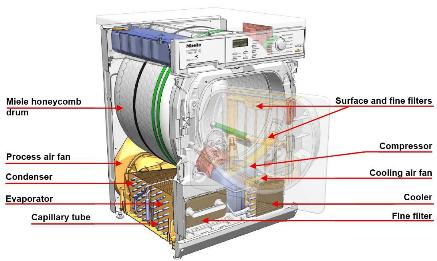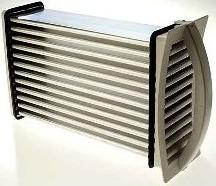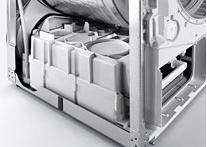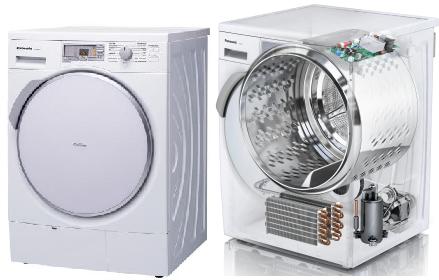We have looked at ways to save electricity when it comes to clothes drying before – Save Electricity with a Spin Dryer, gas tumble dryers, and drying clothes indoors.
Obviously in the ideal world we would all hang our washing outside to dry, but anyone living in the UK who has children knows that this is not always possible – particularly in the winter, autumn, spring, and summer! Hanging clothes to dry indoors increases humidity which reduces the efficiency of home heating and ventilating the room in which the clothes are drying to avoid this lets all the heat out, so if you have a lot of washing to dry it becomes impractical.
Having settled on using a tumble dryer (ideally having first put the clothes through a spin dryer) the best option has been to purchase the most energy efficient model you can afford. A condenser tumble dryer is the better option since a dryer which vents to the outside sucks warm air from inside the house increasing heating costs. A gas powered tumble dryer is much cheaper to run (since gas is cheaper than electricity) and also more efficient since the gas is being used where it is needed to make heat rather than being burned in a power station (generating waste heat) and being sent down electricity cables to you.

Recently a new option became available – the Heat Pump Tumble Dryer. This is an electricity powered tumble dryer which is almost 50% more efficient than the most efficient electric tumble dryers.
Heat Pump Tumble Dryer Technology
In a standard electric tumble dryer, there is a heating element and a motor. The motor turns the drum in which you put the wet clothes, and also drives a fan which blows heated air into the drum. The heat causes the water in the clothes to evaporate and the expensively heated moist air is then expelled through a vent in the wall to the outside.

In the case of a condensing dryer, the hot moist air from the drum is blown through a passive heat exchanger (pictured above, and cooled by ambient air) which cools the hot moist air so that water condenses (as droplets) which are collected in a removable container for you to pour away. The still warm, but now dry air is then re-circulated past the heating element into the drum again making it quite efficient.

So, how does a heat pump tumble dryer improve on the efficiency of an A rated condenser dryer? Instead of passing the hot moist air through an ambient air cooled heat exchanger, it is passed through a heat pump (pictured above), and instead of heating the air in the drum with an element it is heated with a heat pump. But what is a heat pump? A heat pump is a device which transfers heat energy from a heat source (place A) to a heat sink (place B), typically with high efficiency. A fridge for example has a heat pump which gets heat from inside a fridge to outside the fridge. An air conditioner has a heat pump which gets heat from inside your home or office and sends it outside.
In the first instance the heat pump acts like an air conditioner in reverse – it takes a small amount of heat from the surrounding ambient air, and makes a small amount of air in the tumble dryer drum hot which causes water to evaporate from the laundry. The heat pump then takes the heat from the hot moist air from the drum causing the water in it to condense out, and the removed heat is recycled to re-heat the now dry air so it can go back through the drum. This closed circuit style of dryer offers typical electricity savings of 40-60% for a heat pump tumble dryer compared to a good condenser tumble dryer. For example the Miele heat pump tumble dryer (T 8627 WP EcoComfort) uses 46% less electricity than the equivalent (very efficient) Miele standard condensing tumble dryer.
An additional benefit of a heat pump tumble dryer is that the operating temperature is lower and so your laundry is better cared for – less chance of shrinkage, everything comes out softer having not been cooked, the drying cycle is faster so less time spent going around and around in a machine getting bashed about and snagged, and the dried laundry comes out needing less ironing.
Buy a Heat Pump Tumble Dryer

These dryers start at around £700 which is approximately double the price of a good A-rated condensing tumble dryer, but if you do a lot of laundry, it will in time pay for itself.
At the time of writing, the following are some of the main manufacturers of heat pump tumble dryers: Miele, Panasonic, Bosch, Hoover, Hotpoint, AEG, Siemens, and Beko have a much cheaper offering but which uses twice as much energy in a drying cycle compared to the others.
At the time of writing (January 2013) the top rated product is the Panasonic NH-P80G1 pictured above offering the lowest annual running costs of just 2.75p per kg of washing dried, at a retail price of around £700, and is 60% more efficient than the standard A class rating. The user manuals for this appliance could be downloaded here if you want to find out more: Panasonic NH-P80G1 User Manual(PDF).